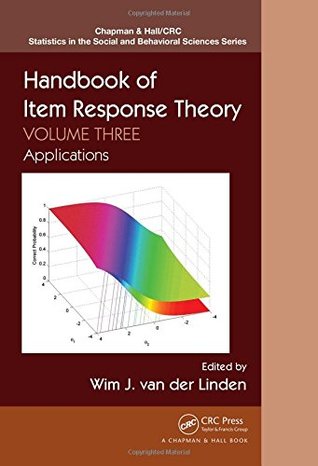Download Handbook of Item Response Theory: Volume 3: Applications - Wim J. van der Linden file in ePub
Related searches:
It provides a powerful means to study individual responses to a variety of stimuli, and the methodology has been extended and developed to cover many different.
Drawing on the work of 75 internationally acclaimed experts in the field, handbook of item response theory, three-volume set presents all major item.
Aug 30, 2016 an authoritative handbook providing a broad overview of irt while also stressing its application to educational and psychological testing.
While these models are not used in healthmeasures, interested individuals can learn more about them in this routledge handbook.
Item response theory (irt) models are stochastic models for two-way data, say, the responses of persons to items. An essential feature of these models is parameter separation, that is, the influences of the items and persons on the responses are modeled by distinct sets of parameters.
Item response theory (irt) has moved beyond the confines of educational measurement into assessment domains such as personality, psychopathology, and patient-reported outcomes. Classic and emerging irt methods and applications that are revolutionizing psychological measurement, particularly for health assessments used to demonstrate treatment.
Drawing on the work of internationally acclaimed experts in the field, handbook of item response theory, volume two: statistical.
His areas of expertise include topics such as item response theory, latent class analysis, diagnostic classification models, and, more broadly, classification and mixture distribution models, computational statistics, person-fit, item-fit, and model checking, hierarchical extension of models for categorical data analysis, and the analytical.
Item response theory (irt) measurement models and associated methods hold much promise for the development, psychometric analysis, refinement, and scoring.
Item response theory has become an essential component in the toolkit of every researcher in the behavioral sciences.
Stanford libraries' official online search tool for books, media, journals, databases, government documents and more.
Item response theory has become an essential component in the toolkit of every researcher in the behavioral sciences. It provides a powerful means to study individual responses to a variety of stimuli, and the methodology has been extended and developed to cover many different models of interaction.
Other names and subsets include item characteristic curve theory, latent trait theory, rasch model, 2pl model, 3pl model and the birnbaum model.
Item response theory (irt) has grown from its roots in postwar mental-testing problems, through intensive use in educational measurements in the 1970s, 1980s.
For the underlying theory we also include references to the according chapters of the second edition of the handbook of item response.
Drawing on the work of internationally acclaimed experts in the field, handbook of item response theory, volume 3: applications presents applications of item response theory to practical testing problems.
Item response theory (irt) is a ubiquitous model for under- standing humans based on their responses to questions, used in fields as diverse as education,.
For many assessment specialists to-day, item response theory (irt) has replaced classical measurement theory as a framework for test development, scale.
In 1997, wim van der linden and ronald hambleton edited the handbook of modern item response theory that gives an overview of the state-of-the-art item response theory models at that time. In 2016, 19 years later, a new handbook is published: handbook of item response theory by wim van der linden.
Throughout this manual, we most often refer to the unobserved characteristic of interest as the latent trait, but we will sometimes also use the term ability.
Item response theory (irt) comprises a collection of mathematical and statistical models and methods that are used in the assembly and scoring of psychological questionnaires and scales. Irt is used to investigate the statistical properties of categorical responses to questions, or other observations that may be indicators on a test or scale.
Drawing on the work of 75 internationally acclaimed experts in the field, handbook of item response theory, three-volume set presents all major item response models, classical and modern statistical tools used in item response theory (irt), and major areas of applications of irt in educational and psychological testing, medical diagnosis of patient-reported outcomes, and marketing research.
Drawing on the work of internationally acclaimed experts in the field, handbook of item response theory, volume one: models presents all major item response models. This first volume in a three-volume set covers many model developments that have occurred in item response theory (irt) during the last 20 years.
Item response theory (irt) was introduced to the field of measurement in the early 1950s (lord. 1952), became increasingly popular in the 60s, 70s and 80s ( see,.
Pdf teorie odpovědi na položku je jednou z dominantních psychometrických teorií měření v psychologii, pedagogickém výzkumu a sociálních vědách vůbec.
Drawing on the work of internationally acclaimed experts in the field, handbook of item response theory, volume 3: applications presents applications of item.
Drawing on the work of internationally acclaimed experts in the field, handbook of item response theory, volume one: models presents all major item response.
Item response theory (irt) is concerned with accurate test scoring and development of test items. You design test items to measure various kinds of abilities (such as math ability), traits (such as extroversion), or behavioral characteristics (such as purchasing tendency).
This book provides a historical overview of item-response theory (irt) and contains a compendium of item-response-theory research.
Item response theory (irt) represents an important innovation in the field of psychometrics. While now 50 years old – assuming the “birth” is the classic lord and novick (1969) text – it is still underutilized and remains a mystery to many practitioners.

Post Your Comments: